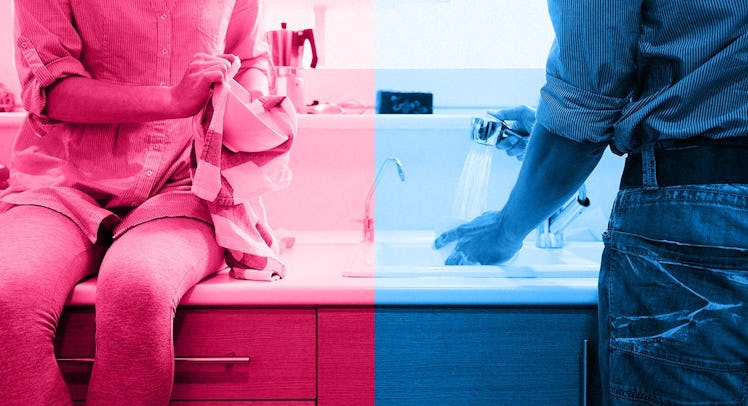Debunking the Myth of the 50-50 Marriage
An even split of emotional, physical, paid, and unpaid labor has never really been manageable in a long-term relationship, and yet the legend lives on.

Attempting to achieve absolute equality, or going 50-50, in a marriage may be a good way to pick a fight about whose turn it is to change the baby’s diaper, but it’s not the best way to maintain a healthy relationship. As important as it is for husbands and wives to carry their own weight, going pound-for-pound is a good way for people get hurt. And while the intent it to support each other, too often it becomes about keeping score.
“The problem with assuming a 50-50 division is the marriage may start to function in a ‘You do this, then I’ll do that’ manner,” psychotherapist Whitney Goodman told Fatherly. “An exact division of labor is often impossible for couple’s to achieve, especially if they value contributions differently.”
Th 50-50 marriage is a fallacy and a trap that stems from a combination of traditional and modern marriage expectations. In more traditional relationships the distribution of responsibilities in marriages was rigidly defined. Women were expected to maintain the home and men were to provide for it. It wasn’t equality, but it was culturally accepted as each person’s fair share. However, as more women entered the workforce and more men have picked up the slack at home, achieving an even split of emotional, physical, paid, and unpaid labor has become more idealized among couples, yet more challenging to achieve than expected. That’s because long-term relationships require flexibility to work. A 50-50 marriage calls for rigidity and leaves many couples disillusioned without realizing why.
“An exact division of labor is often impossible for couple’s to achieve, especially if they value contributions differently.“
In reality, the notion of this type of marriage has never really played out in the data, even in more modern egalitarian marriages. Despite increasing women’s share of full-time paid increasing from 34 percent to 48 percent since 1975, their responsibilities in the home have only declined from 81 to 72 percent in the same period, research out of Harvard found. Other studies demonstrate a similarly small decline in housework for work for working moms, and not much of an increase in housework for working dads.
That’s not to say men aren’t doing any housework, and they’ve been particularly amenable to absorbing cooking and care-taking roles. But they have not been assuming every chore or doing it at the same rate. One possible explanation? Unpaid labor in the home is often devalued, and some men struggle with that more than others.
“While women have lots of incentive to advocate for access to high prestige educational and professional positions, men have less incentive to advocate for access to more devalued care work,” Alexandra Killewald, author of the Harvard study, told Fatherly. Until work in the home is similarly valued socially, couples looking for a 50-50 marriage are putting a false premise on a pedestal.
Of course, the pursuit of an equitable marriage in itself, is not a bad thing. Perhaps part of the reason the myth of the 50-50 marriage lives on is that the division of labor in a marriage is vital. Killewald found that how much couples valued each other’s contribution to shared responsibilities predicted marriage success, but there’s just not a one-size fits all ratio for couples. The strongest marriages seem to accept that the equation changes by the day, and sometimes by the hour, and is open to negotiation. It’s likely never going to land on 50 percent a piece.
The strongest marriages seem to accept that the equation changes by the day, and sometimes by the hour, and is open to negotiation.
The main risk couples run into in the pursuit of a 50-50 relationship is replacing competition for communication, couples therapist Brandon Santan warns. “Trying to obtain a 50-50 balance in roles and responsibilities can lead very quickly to the highly toxic elements of resentment and negativity because it’s too competitive,” he explained. “On the surface it does seem like a good idea, but it can really be a stumbling block for couples.”
Ultimately, even if a 50-50 marriage were attainable it would not be worth it because it would make marriages extremely vulnerable to change, Goodman and Santan agree. When someone gets sick or loses a job, strong and healthy marriages can bend, while 50-50 marriages are far more likely to break.
“The way you divide your labor can always change and should if your circumstance change,” Goodman says. “Couples should consistently check in with one another about their division of labor and make sure it’s fair and reasonable for both parties.”
This article was originally published on